GMC SONOMA 2003 Service Manual
Manufacturer: GMC, Model Year: 2003, Model line: SONOMA, Model: GMC SONOMA 2003Pages: 424, PDF Size: 2.45 MB
Page 41 of 424
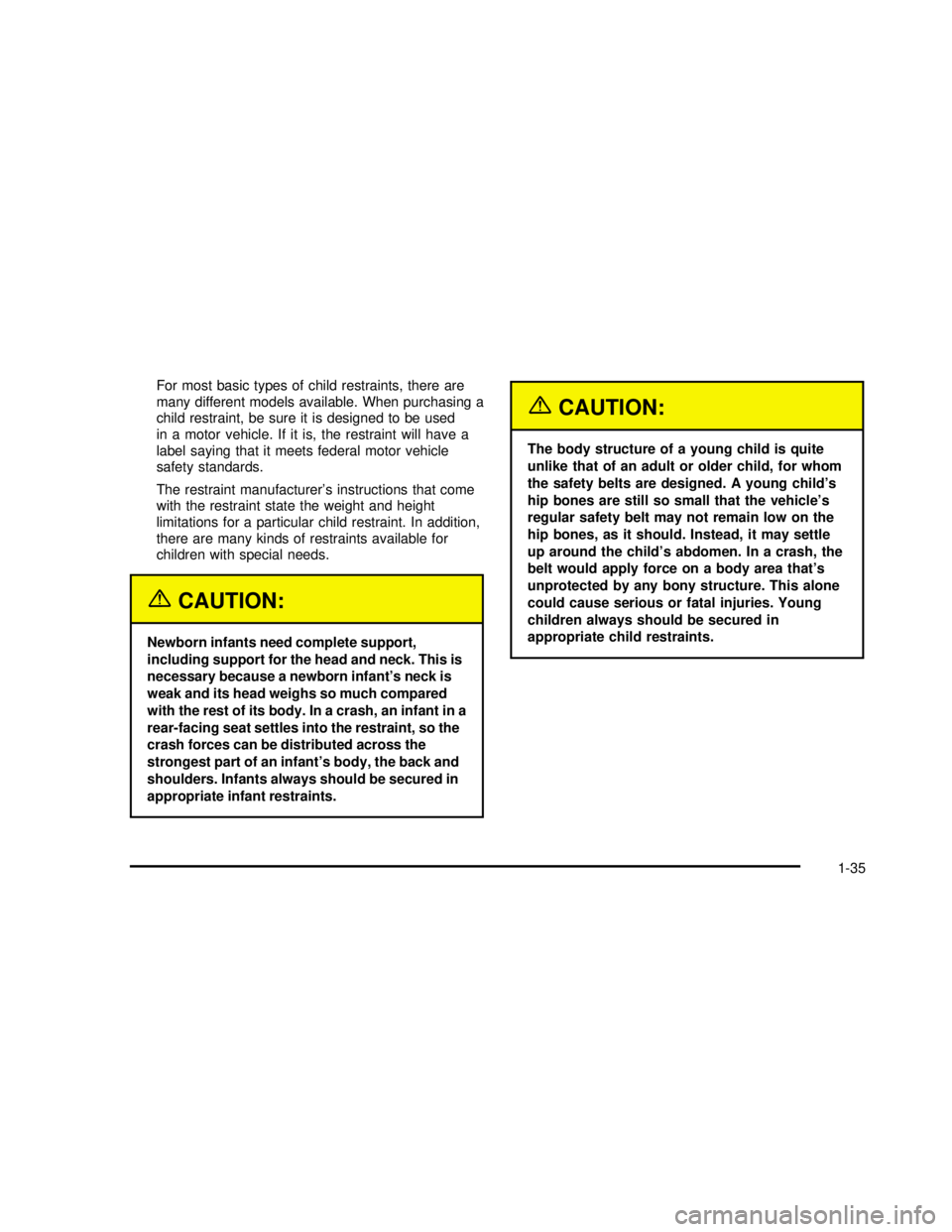
For most basic types of child restraints, there are
many different models available. When purchasing a
child restraint, be sure it is designed to be used
in a motor vehicle. If it is, the restraint will have a
label saying that it meets federal motor vehicle
safety standards.
The restraint manufacturer’s instructions that come
with the restraint state the weight and height
limitations for a particular child restraint. In addition,
there are many kinds of restraints available for
children with special needs.
{CAUTION:
Newborn infants need complete support,
including support for the head and neck. This is
necessary because a newborn infant’s neck is
weak and its head weighs so much compared
with the rest of its body. In a crash, an infant in a
rear-facing seat settles into the restraint, so the
crash forces can be distributed across the
strongest part of an infant’s body, the back and
shoulders. Infants always should be secured in
appropriate infant restraints.
{CAUTION:
The body structure of a young child is quite
unlike that of an adult or older child, for whom
the safety belts are designed. A young child’s
hip bones are still so small that the vehicle’s
regular safety belt may not remain lowon the
hip bones, as it should. Instead, it may settle
up around the child’s abdomen. In a crash, the
belt would apply force on a body area that’s
unprotected by any bony structure. This alone
could cause serious or fatal injuries. Young
children always should be secured in
appropriate child restraints.
1-35
2003 - Sonoma OM
Page 42 of 424
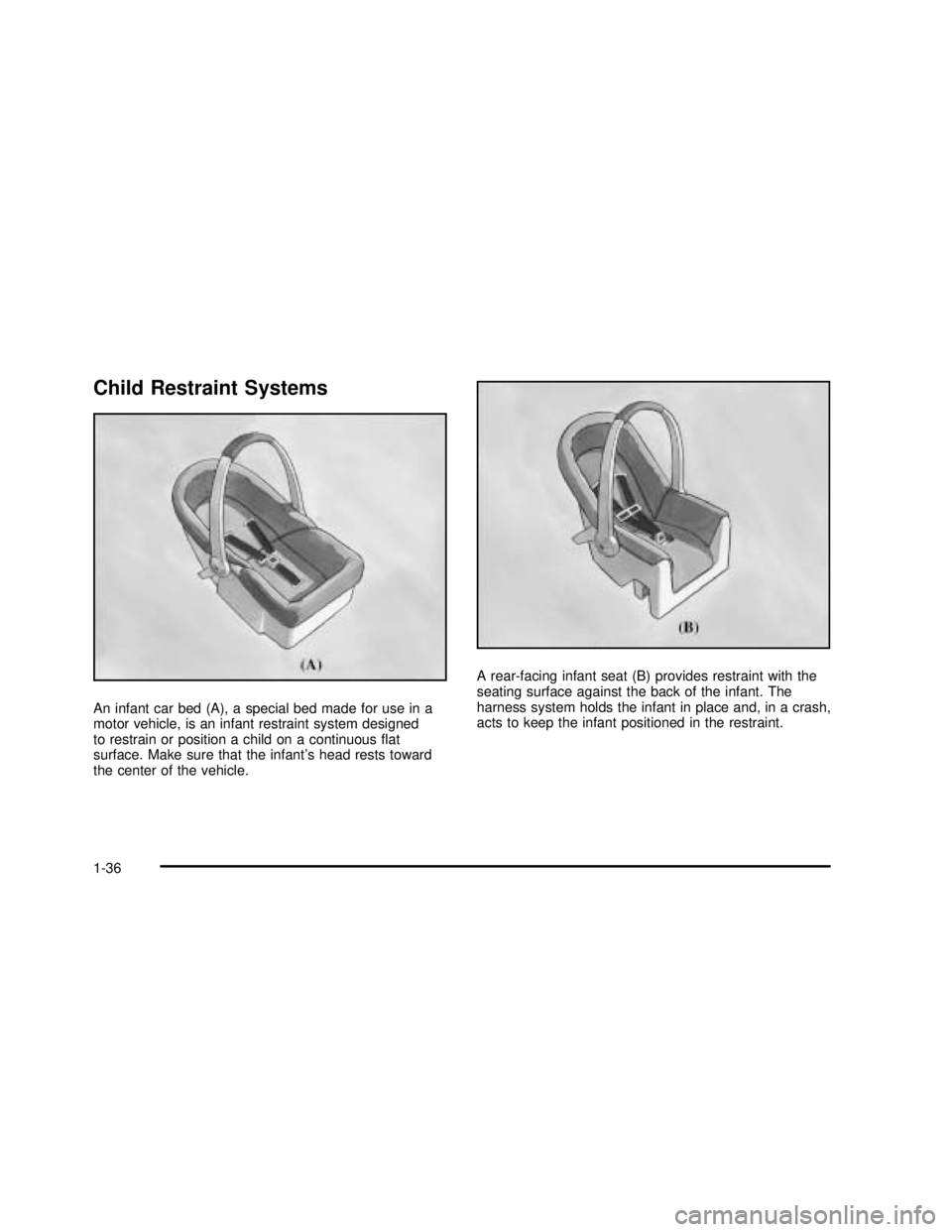
Child Restraint Systems
An infant car bed (A), a special bed made for use in a
motor vehicle, is an infant restraint system designed
to restrain or position a child on a continuousflat
surface. Make sure that the infant’s head rests toward
the center of the vehicle.A rear-facing infant seat (B) provides restraint with the
seating surface against the back of the infant. The
harness system holds the infant in place and, in a crash,
acts to keep the infant positioned in the restraint.
1-36
2003 - Sonoma OM
Page 43 of 424
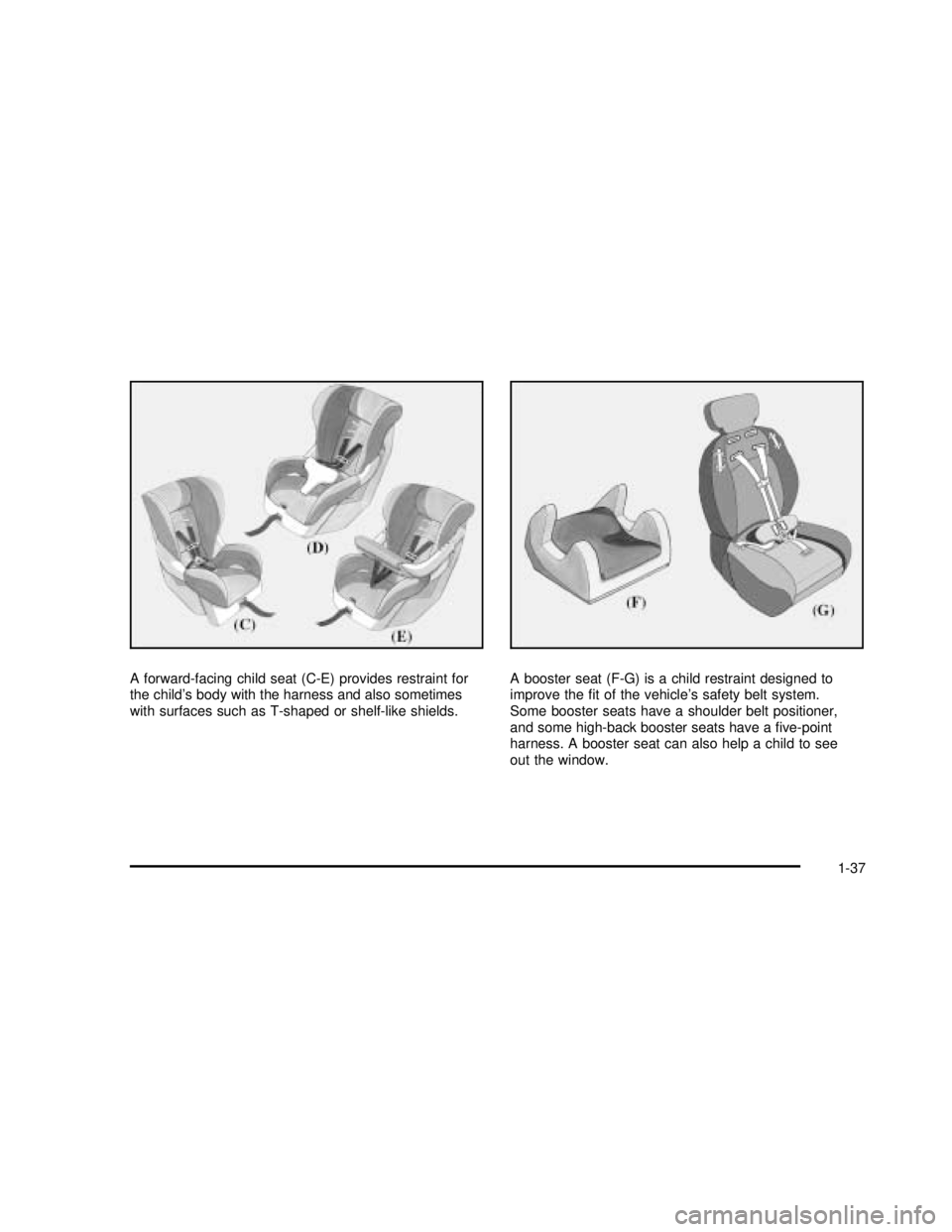
A forward-facing child seat (C-E) provides restraint for
the child’s body with the harness and also sometimes
with surfaces such as T-shaped or shelf-like shields.A booster seat (F-G) is a child restraint designed to
improve thefit of the vehicle’s safety belt system.
Some booster seats have a shoulder belt positioner,
and some high-back booster seats have afive-point
harness. A booster seat can also help a child to see
out the window.
1-37
2003 - Sonoma OM
Page 44 of 424
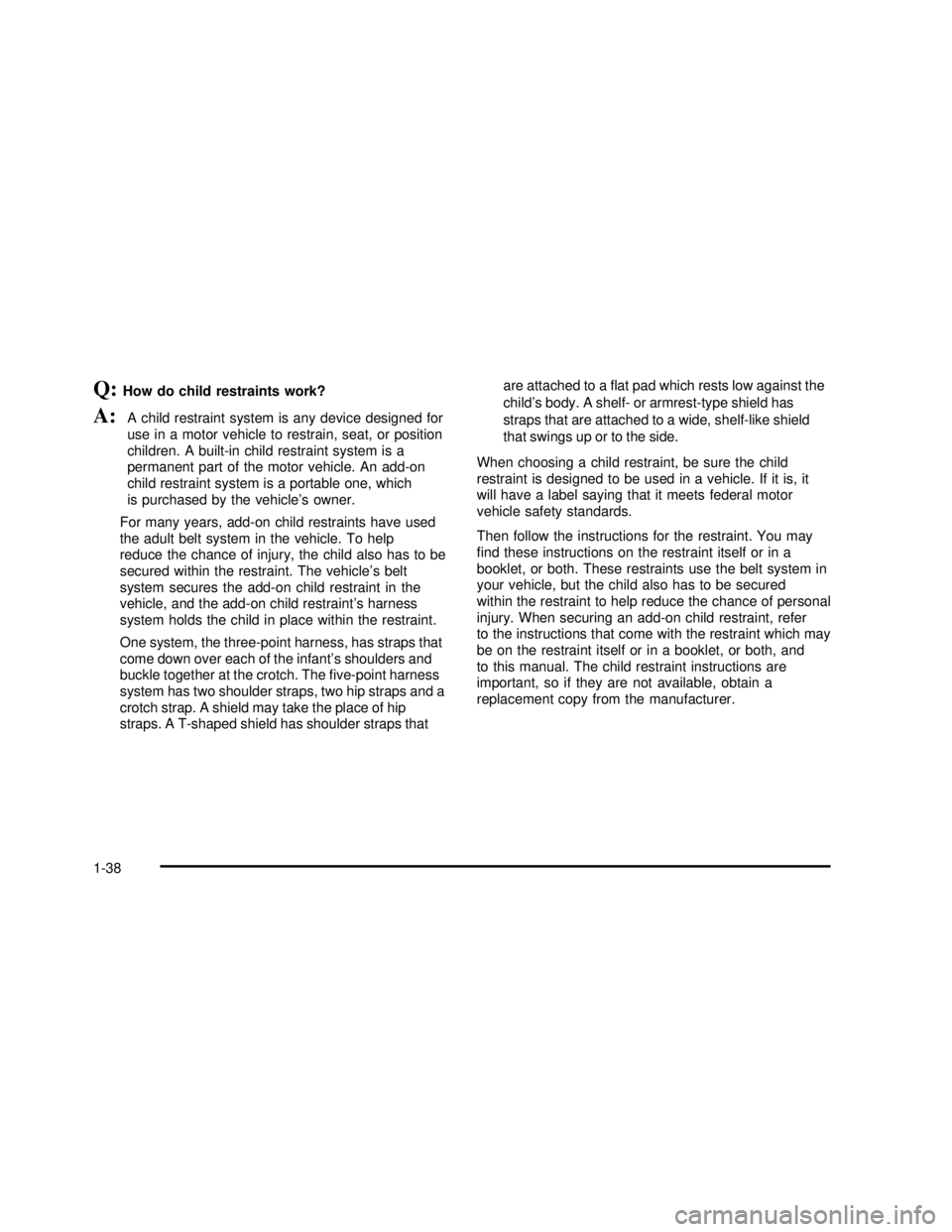
Q:Howdo child restraints work?
A:A child restraint system is any device designed for
use in a motor vehicle to restrain, seat, or position
children. A built-in child restraint system is a
permanent part of the motor vehicle. An add-on
child restraint system is a portable one, which
is purchased by the vehicle’s owner.
For many years, add-on child restraints have used
the adult belt system in the vehicle. To help
reduce the chance of injury, the child also has to be
secured within the restraint. The vehicle’s belt
system secures the add-on child restraint in the
vehicle, and the add-on child restraint’s harness
system holds the child in place within the restraint.
One system, the three-point harness, has straps that
come down over each of the infant’s shoulders and
buckle together at the crotch. Thefive-point harness
system has two shoulder straps, two hip straps and a
crotch strap. A shield may take the place of hip
straps. A T-shaped shield has shoulder straps thatare attached to aflat pad which rests low against the
child’s body. A shelf- or armrest-type shield has
straps that are attached to a wide, shelf-like shield
that swings up or to the side.
When choosing a child restraint, be sure the child
restraint is designed to be used in a vehicle. If it is, it
will have a label saying that it meets federal motor
vehicle safety standards.
Then follow the instructions for the restraint. You may
find these instructions on the restraint itself or in a
booklet, or both. These restraints use the belt system in
your vehicle, but the child also has to be secured
within the restraint to help reduce the chance of personal
injury. When securing an add-on child restraint, refer
to the instructions that come with the restraint which may
be on the restraint itself or in a booklet, or both, and
to this manual. The child restraint instructions are
important, so if they are not available, obtain a
replacement copy from the manufacturer.
1-38
2003 - Sonoma OM
Page 45 of 424
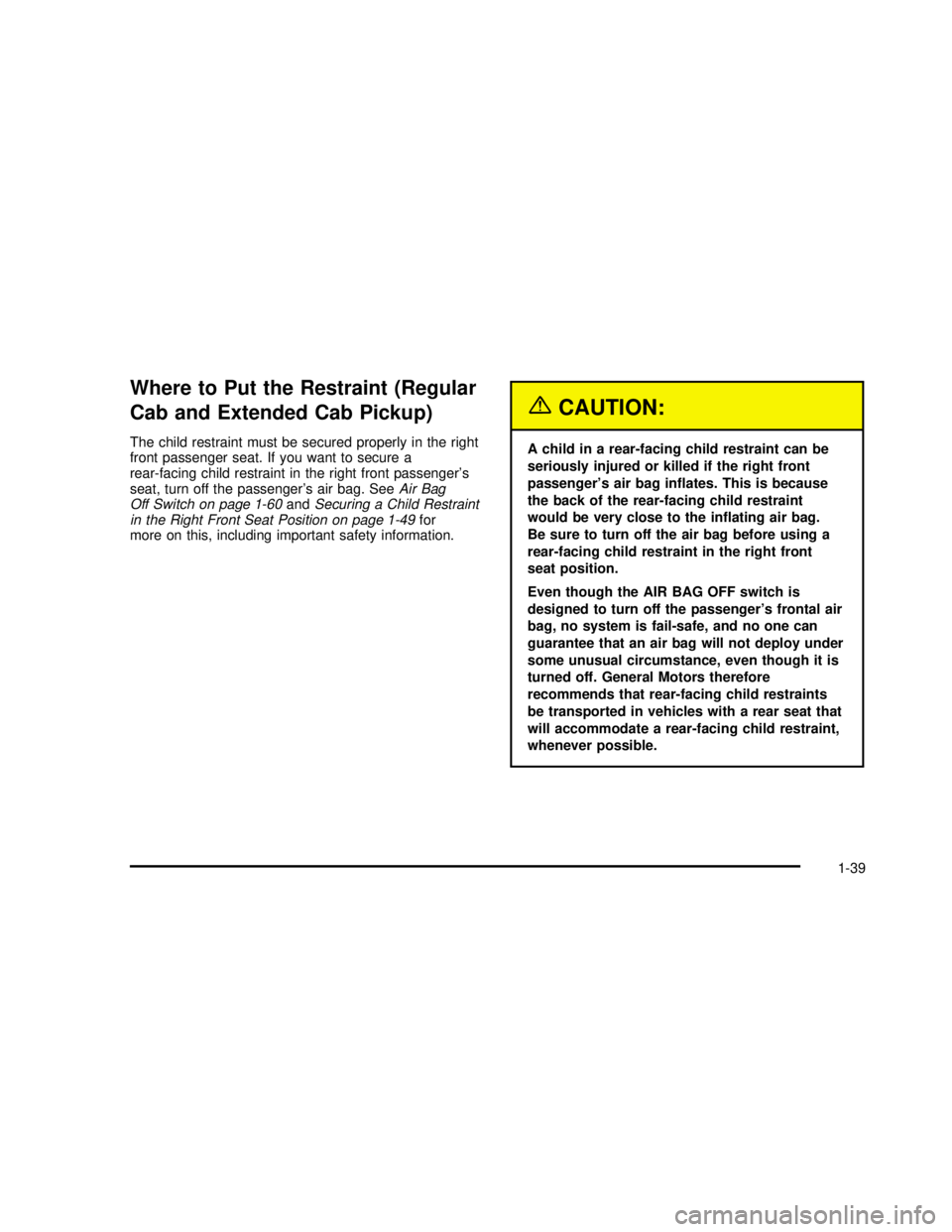
Where to Put the Restraint (Regular
Cab and Extended Cab Pickup)
The child restraint must be secured properly in the right
front passenger seat. If you want to secure a
rear-facing child restraint in the right front passenger’s
seat, turn off the passenger’s air bag. SeeAir Bag
Off Switch on page 1-60andSecuring a Child Restraint
in the Right Front Seat Position on page 1-49for
more on this, including important safety information.
{CAUTION:
A child in a rear-facing child restraint can be
seriously injured or killed if the right front
passenger’s air bag inflates. This is because
the back of the rear-facing child restraint
would be very close to the inflating air bag.
Be sure to turn off the air bag before using a
rear-facing child restraint in the right front
seat position.
Even though the AIR BAG OFF switch is
designed to turn off the passenger’s frontal air
bag, no system is fail-safe, and no one can
guarantee that an air bag will not deploy under
some unusual circumstance, even though it is
turned off. General Motors therefore
recommends that rear-facing child restraints
be transported in vehicles with a rear seat that
will accommodate a rear-facing child restraint,
whenever possible.
1-39
2003 - Sonoma OM
Page 46 of 424
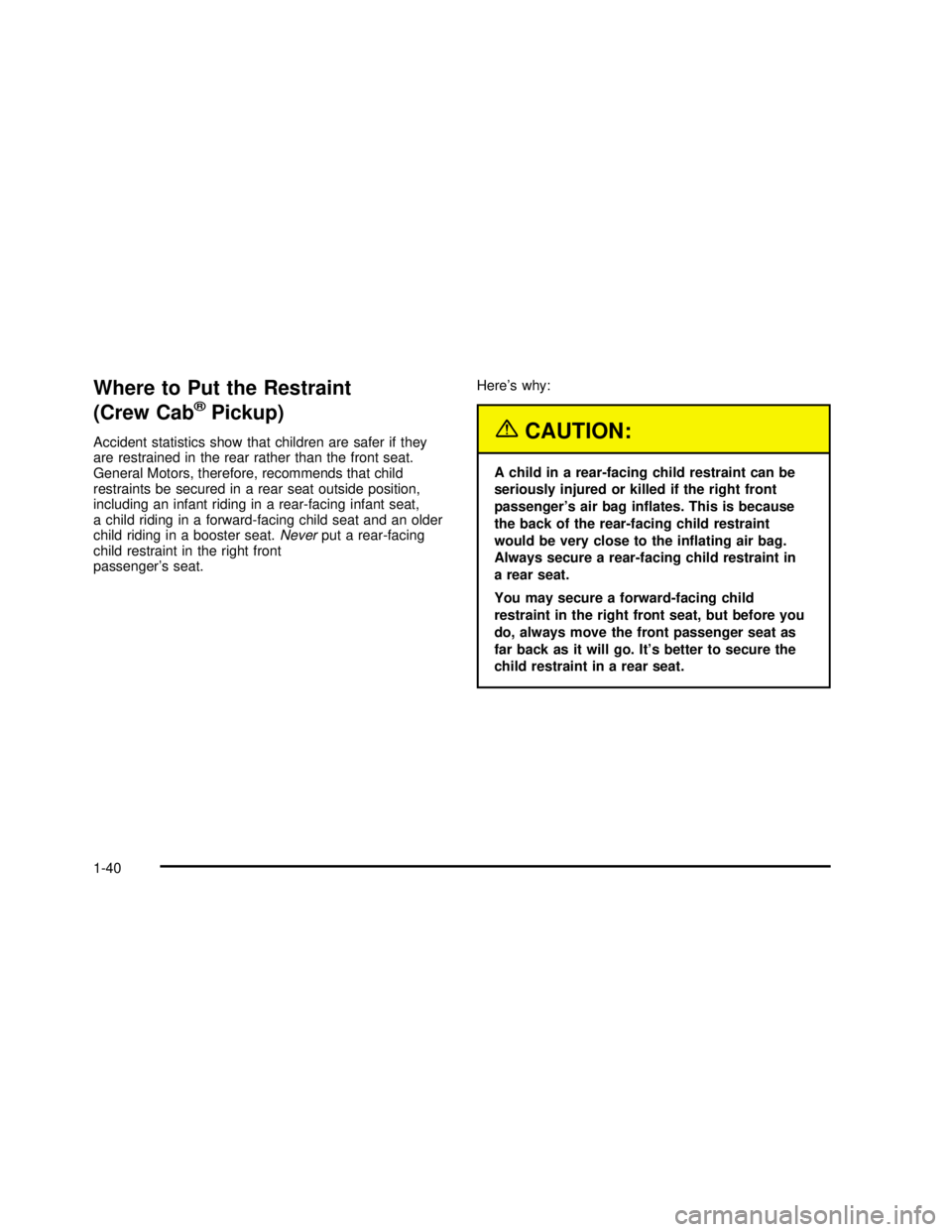
Where to Put the Restraint
(CrewCab
®Pickup)
Accident statistics show that children are safer if they
are restrained in the rear rather than the front seat.
General Motors, therefore, recommends that child
restraints be secured in a rear seat outside position,
including an infant riding in a rear-facing infant seat,
a child riding in a forward-facing child seat and an older
child riding in a booster seat.Neverput a rear-facing
child restraint in the right front
passenger’s seat.Here’s why:{CAUTION:
A child in a rear-facing child restraint can be
seriously injured or killed if the right front
passenger’s air bag inflates. This is because
the back of the rear-facing child restraint
would be very close to the inflating air bag.
Always secure a rear-facing child restraint in
a rear seat.
You may secure a forward-facing child
restraint in the right front seat, but before you
do, always move the front passenger seat as
far back as it will go. It’s better to secure the
child restraint in a rear seat.
1-40
2003 - Sonoma OM
Page 47 of 424
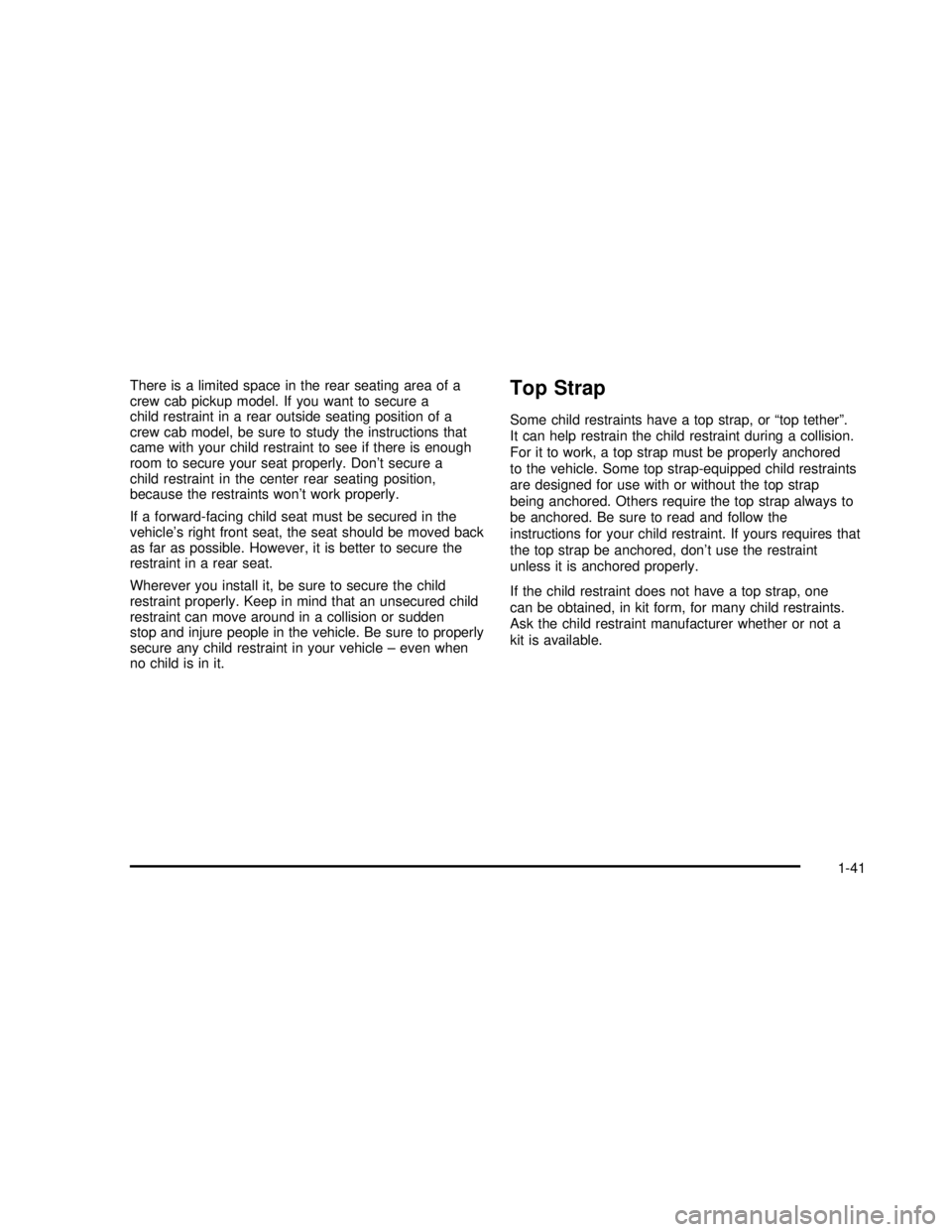
There is a limited space in the rear seating area of a
crew cab pickup model. If you want to secure a
child restraint in a rear outside seating position of a
crew cab model, be sure to study the instructions that
came with your child restraint to see if there is enough
room to secure your seat properly. Don’t secure a
child restraint in the center rear seating position,
because the restraints won’t work properly.
If a forward-facing child seat must be secured in the
vehicle’s right front seat, the seat should be moved back
as far as possible. However, it is better to secure the
restraint in a rear seat.
Wherever you install it, be sure to secure the child
restraint properly. Keep in mind that an unsecured child
restraint can move around in a collision or sudden
stop and injure people in the vehicle. Be sure to properly
secure any child restraint in your vehicle–even when
no child is in it.Top Strap
Some child restraints have a top strap, or“top tether”.
It can help restrain the child restraint during a collision.
For it to work, a top strap must be properly anchored
to the vehicle. Some top strap-equipped child restraints
are designed for use with or without the top strap
being anchored. Others require the top strap always to
be anchored. Be sure to read and follow the
instructions for your child restraint. If yours requires that
the top strap be anchored, don’t use the restraint
unless it is anchored properly.
If the child restraint does not have a top strap, one
can be obtained, in kit form, for many child restraints.
Ask the child restraint manufacturer whether or not a
kit is available.
1-41
2003 - Sonoma OM
Page 48 of 424
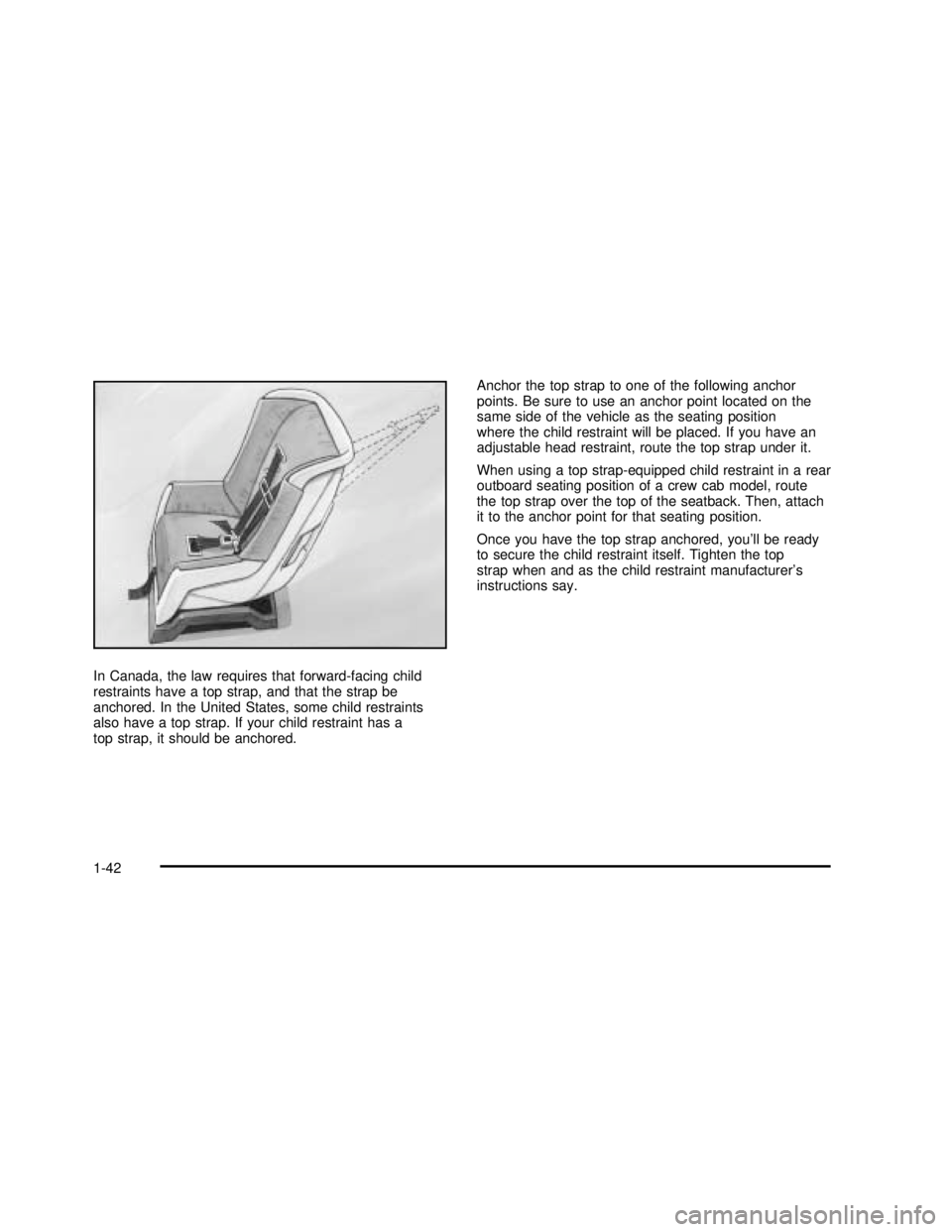
In Canada, the law requires that forward-facing child
restraints have a top strap, and that the strap be
anchored. In the United States, some child restraints
also have a top strap. If your child restraint has a
top strap, it should be anchored.Anchor the top strap to one of the following anchor
points. Be sure to use an anchor point located on the
same side of the vehicle as the seating position
where the child restraint will be placed. If you have an
adjustable head restraint, route the top strap under it.
When using a top strap-equipped child restraint in a rear
outboard seating position of a crew cab model, route
the top strap over the top of the seatback. Then, attach
it to the anchor point for that seating position.
Once you have the top strap anchored, you’ll be ready
to secure the child restraint itself. Tighten the top
strap when and as the child restraint manufacturer’s
instructions say.
1-42
2003 - Sonoma OM
Page 49 of 424
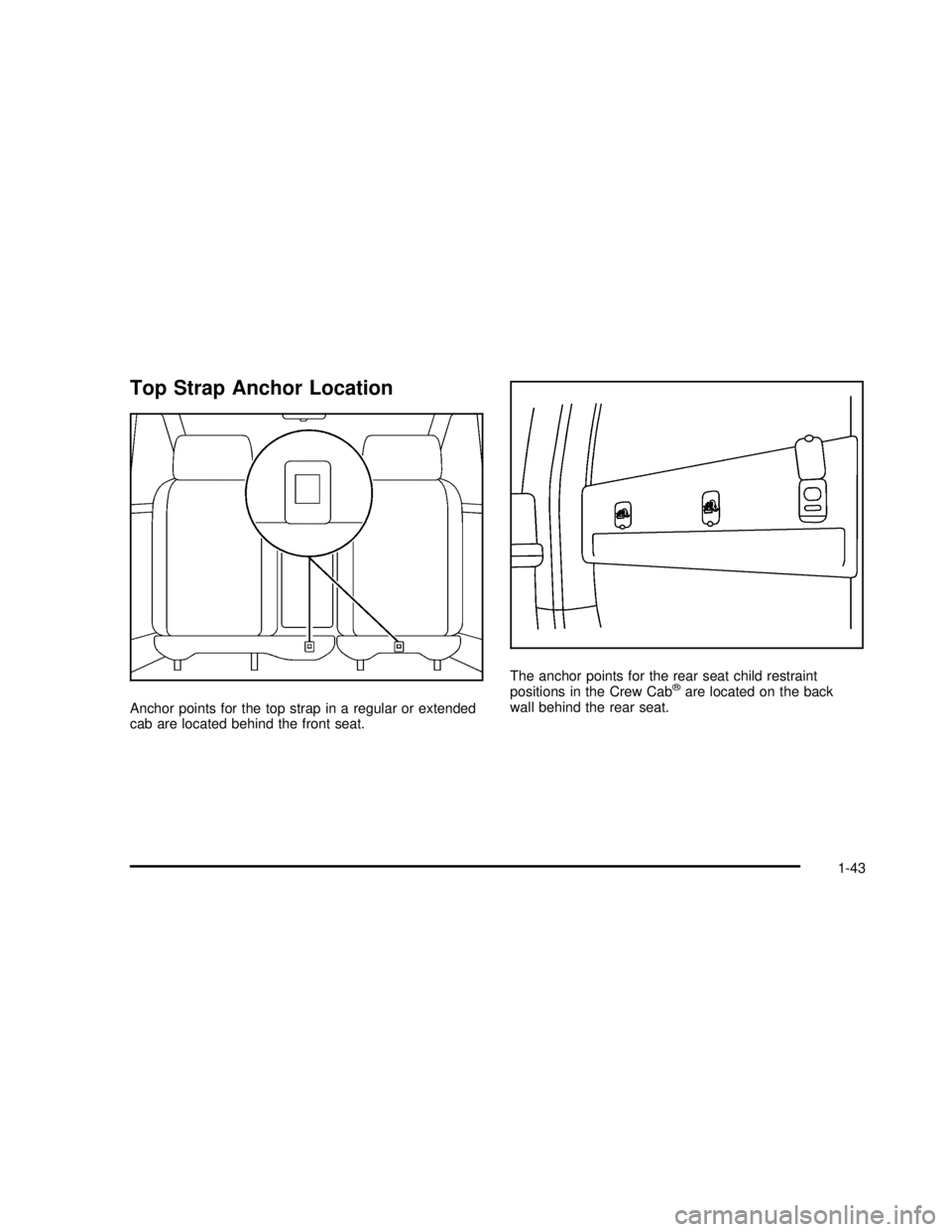
Top Strap Anchor Location
Anchor points for the top strap in a regular or extended
cab are located behind the front seat.The anchor points for the rear seat child restraint
positions in the Crew Cab
®are located on the back
wall behind the rear seat.
1-43
2003 - Sonoma OM
Page 50 of 424
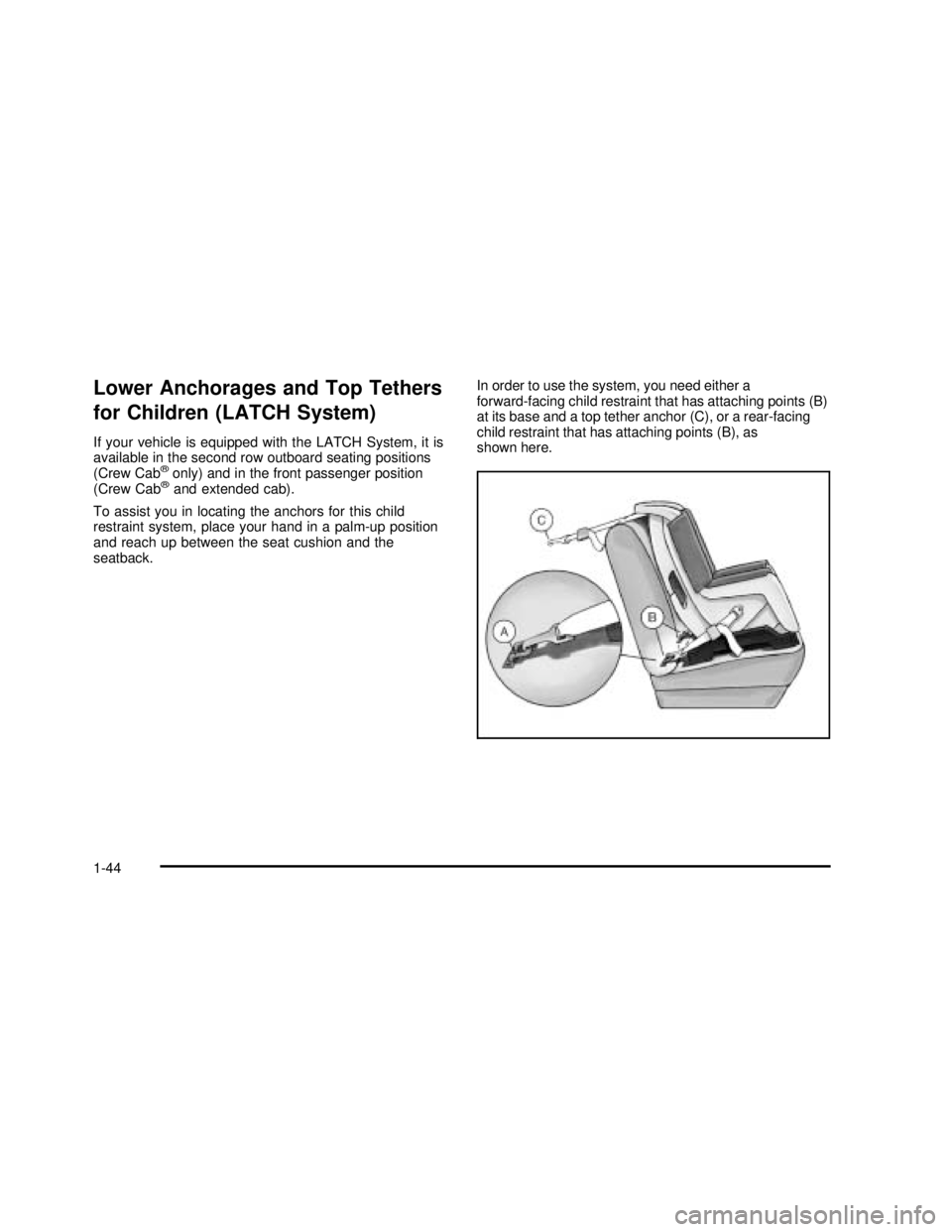
Lower Anchorages and Top Tethers
for Children (LATCH System)
If your vehicle is equipped with the LATCH System, it is
available in the second row outboard seating positions
(Crew Cab
®only) and in the front passenger position
(Crew Cab®and extended cab).
To assist you in locating the anchors for this child
restraint system, place your hand in a palm-up position
and reach up between the seat cushion and the
seatback.In order to use the system, you need either a
forward-facing child restraint that has attaching points (B)
at its base and a top tether anchor (C), or a rear-facing
child restraint that has attaching points (B), as
shown here.
1-44
2003 - Sonoma OM